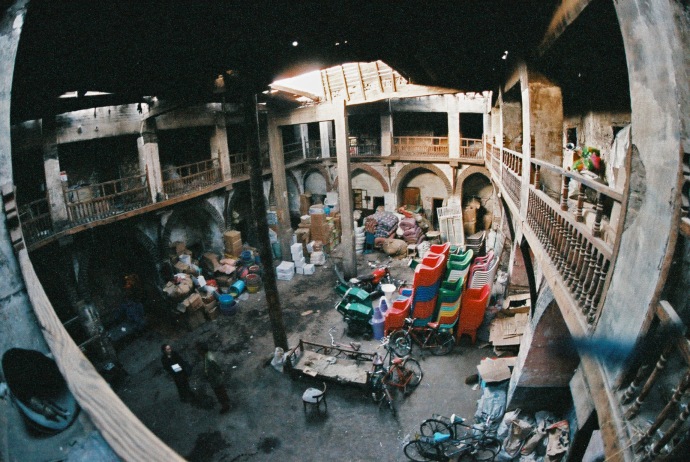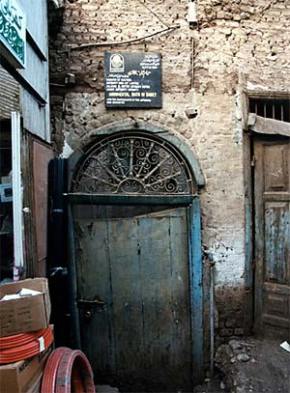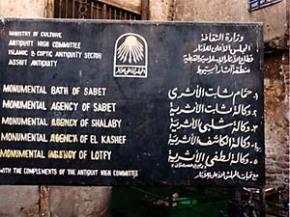Once a major commercial and industrial centre in the Ottoman era, Assiut is known for its wikalas where merchants and traders used to assemble to sell their goods. Despite their historical importance, they are neglected.
Well-known for its Pharaonic and Christian monuments, Assiut is still more in the business of daily living than shuttling tourists from site to site. A relaxing and picturesque city, it is nonetheless heavily populated and hardly accustomed to catering to the needs and expectations of the foreign traveller. But as someone familiar with this generally undervisited city, I have always appreciated my visits as an opportunity to explore the area’s lesser-known spots.
Assiut is a natural departure point for interesting sites like the rock tombs of Mier and the Coptic monasteries of Dronka and Al-Muharraq. But during my last visit, when I found myself with some extra time on my hands, I decided to search for something new. A friend had suggested I go to the western part of the city and visit the wikalas in Al-Qesariyya. “It’s the oldest part of the city,” Adel told me, “and if you want to capture the real spirit of old Assiut, that is the place to go.”
Not that I didn’t trust my friend Adel, but I wasn’t so sure. So when he started to tell me how the wikalas — old commercial centres housed in large buildings — in Assiut were comparable to the vibrant trading centres we have in Cairo, like Wikalat Al-Ghuri and Wikalat Al-Balah, I got interested. What he didn’t tell me was that the communal trading of Assiut’s old wikalas is alive and well: the wikalas, however, barely remain.
Photo: Ayman Ibrahim
The wikala has served many functions, both as public and private space, since its introduction in Egypt during the Fatimid era. Historically, however, wikalas were large buildings, usually two stories, where merchants and traders assembled in a large main hall to sell their goods. Off the main communal area were chambers used for storing the merchants’ goods and the upper floor functioned as something of an inn, providing rooms complete with kitchens and bathrooms for itinerant traders. Money raised from the wikala sometimes went toward an adjacent mosque — the builder or owner’s way of offering a community service. Wikalas continued to be a feature of urban society through to Ottoman times.
Ready to take on the wikalas of Al-Qesariyya, I left my hotel in Assiut early in the morning, thinking it would be a straightforward journey westward. But like most big cities, Assiut’s streets were crowded with women and children buying the day’s household needs and people making their way to work. Students and school-children clogged the little road space that wasn’t blocked up with cars. I seemed to have hit the rush hour and it was hard going.
Stuck in the car, I had a little time to contemplate Assiut as the major commercial and industrial centre it once was in the Ottoman era. A major stop on the Darb Al-Arbi’in road, which leads south, Assiut was also famous for its textile and oil industries. Merchants regularly passed through the city, either as a stopover or to replenish their supplies on their way to what is now Sudan. With this in mind, I had envisaged Assiut’s wikalas to be grand, stately halls, perhaps tarnished and worn down by time, but still carrying vestiges of their former prominence.
When I finally reached Al-Qesariyya, what I found was a far cry from what I had imagined. I found myself in a large, bustling marketplace with rows of shops on both sides stocked with every item imaginable: food, clothes, spices, plastics, perfume, vegetables, fruit. I saw carpenters, upholsterers, blacksmiths and other craftsmen at work. The marketplace was colourful and buzzing with activity — but where were the wikalas?
Photo: Ayman Ibrahim
It didn’t take long to realise that the historic wikalas were not monuments to be visited and toured; they were simply crumbling buildings interspersed among the modern trading areas. Goods were displayed and stored alongside ahwas (coffee shops), where the merchants gathered, drinking, smoking and socialising. They may be historic Ottoman sites, but to the locals of west Assiut, they were nothing more than walls on which to lean. I was tempted to give up and go back to my hotel when I spotted a big billboard in the middle of the marketplace — a professional sign that looked like a tourist marker bearing the names of the wikalas and the so-called Bath of Sabet.
I sought out the Bath of Sabet, only to find that it was closed. After asking around, I found a guard who told me that the site was being restored, but I found no evidence of this in its run-down entrance or the painfully neglected surroundings. Feeling somewhat discouraged, I decided to check the place out anyhow, and was allowed in. From the moment I entered, I saw immediately that the bath, comprised of several halls used for different stages of hot water and steam, was once quite beautiful. We passed through another domed hall into the central hall, its floor made of marble and dotted with a number of benches where people could rest after their bath and sauna.
In one of the few books on Assiut I was able to lay my hands on, the Bath of Sabet is described as the only medieval public bath in Assiut and its neighbouring cities. Situated beside the mosque of Galaleddin El-Siyouti, its architecture is said to be unique. To me, the tourist potential was obvious, but whatever the previous efforts to take advantage of the site were, they have long since crumbled with the scaling walls. The monument is in sorrowful condition. The wikalas I found in Al-Qesariyya have hardly fared better.
laWikalat Lutfi, whose western facade overlooks Al-Khan alley, was built in 1629 by Lutfi Abdel-Gawad, then one of Egypt’s important magnates. Lutfi turned the wikala into a waqf (charitable endowment), which would benefit the neighbouring mosque that bore his name. Wikalat Al-Kashef was built by Prince Mohamed Kashef Bekzada in 1821. Wikalat Sabet, situated alongside the mosque of Galaleddin El-Siyouti and overlooking Mohamed Mahmoud Pasha Street, was built by Mohamed Sabet in 1822. Down the street from Wikalat Sabet is Wikalat Shalabi, built two years later.
In 1853, Wikalat Mohamed El-Hilali, a commanding 23-room structure built with rock and roofed with palm tree trunks, was established by Hagg Mohamed Farghali Abdel-Fatah El-Hilali. El-Hilali, then the head of the merchants guild, was said to have had good trade connections with Sudan. Moreover, he was also a relative of Omar Makram, who at the time was a prominent Egyptian leader under Mohamed Ali.
Surprised to find that such precious historic sites were so poorly treated, I looked into the matter on my return to Cairo. Speaking with Amaal El-Amri of the Faculty of Antiquities at Cairo University, I learned that of the nine wikalas established in Assiut, only five remain. “They are of great historical importance,” El-Amri told me. “However, their state is miserable. Too many people and sellers have encroached on them.”
Well, I had experienced this for myself. Upon entering one of the wikalas in Al-Qesariyya, I found a group of merchants occupying most of the building, with every corner and storage space crammed full of either goods or garbage. Here plastics, there cartons, in a far corner, metal tins. The second floor, once a comfortable hotel for traders, looked as though it was on the verge of collapse. But no sooner had I asked my accompanying photographer to take some photos of the interior than a guard materialised out of nowhere warning that pictures were “mamnu’a!” (forbidden). This, I was told, was because the site was “under restoration” — yet I noticed that this antiquities guard did not seem to think that merchants sitting around smoking shisha (waterpipe) and using the place as a private shop was a threat to the supposed restoration.
El-Amri scoffed at the situation as “absurd,” claiming that the Supreme Council of Antiquities (SCA) should save the sites since the wikalas of Assiut are the only places there that dates back to the Ottoman era. When asked about the local inhabitants who have inhabited the area, she added, “these people will have to be relocated before any restoration begins.”
Sometimes, the more you dig, the more you find that you might have been better off never knowing. I left Assiut with mixed feelings this time around, having discovered an area of the city comparable in historic relevance to many places in Old Cairo — but also saddened by the decrepit condition in which these sites remain. Forgotten by time and deemed, for the time being, unworthy of restoration, I realised that there was little hope for the wikalas of Assiut. And though I have always enjoyed this city, I worry about what other assets the city may hold, buried in neglect.



